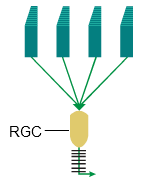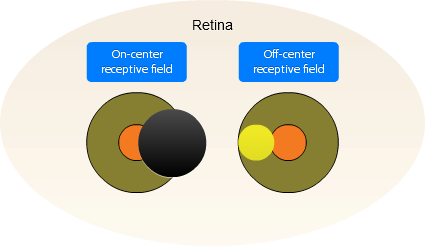Chapter 2. Receptive Fields of Retinal Ganglion Cells
2.1 Title slide

Receptive Fields of Retinal Ganglion Cells
Control the intensity, size, and location of spots of light striking the receptive fields of retinal ganglion cells, to map their responses.
CLICK ANYWHERE TO BEGIN
Photo: Republished with permission of Society for Neuroscience, from Vaney, D.I. (1994) Territorial organization of direction-selective ganglion cells in rabbit retina. Journal of Neuroscience, Vol. 14, 6301–6316; permission conveyed through Copyright Clearance Center, Inc.
How Do Neural Circuits Detect Motion?

Mammalian RGCs have a center–surround receptive field—stimulation of the center of the receptive field evokes a different response from the RGC than does stimulation of the surrounding portion of the receptive field. Center–surround receptive fields can be either on-center or off-center, with correspondingly different patterns of response from the RGCs. (See figure in the text.)

• Cells with on-center receptive fields increase their firing rate when the amount of light striking the center of the cell's receptive field increases relative to the amount of light striking the surround. This can occur either by increasing the amount striking the center or by decreasing the amount striking the surround. The RGC responds in the opposite way to relative decreases of light in the center—for example, when the relative amount of light striking the surround increases, on-center cells decrease their firing rate. The preferred stimulus for an RGC with an on-center receptive field—that is, the stimulus that causes the greatest increase in the cell's firing rate—is a spot of bright light that covers the entire center of the receptive field without touching the surround.
• Cells with off-center receptive fields increase their firing rate when the amount of light striking the center decreases relative to the amount striking the surround—a response pattern that's important when we're looking at dark objects on a bright background. These RGCs decrease their firing rate when the amount of light striking the center increases relative to the amount striking the surround. For an RGC with an off-center receptive field, the preferred stimulus would be a dark spot covering the entire center without touching the surround.
For both types of RGCs, light that uniformly covers both the center and the surround causes very little change in the firing rate, because the response prompted by stimulation of the center is largely "canceled out" by the response prompted by stimulation of the surround. This reveals a very important point: RGCs don't respond much to uniform illumination; rather, they respond to luminance contrast, a difference between the brightness of the light striking the center versus the surround of their receptive field.
2.2 Explain - dnd
Drag and drop a stimulus to project a spot of bright light or a dark spot on a light background
onto the retina. See how the location of the projected spot affects the firing
rate of the two retinal ganglion cells (RGCs).
Can you
determine which RGC receptive field is on-center and which is off-center? Click SHOW RECEPTIVE FIELD TYPES to see the answer.
2.3 Explain
How Do Retinal Ganglion Cells with On-Center and Off-Center Receptive Fields Differ in Their Response to Light?
The receptive field of a retinal ganglion cell (RGC) is the region of the retina in which the presence of a stimulus (e.g., a spot of light) causes a change in the RGC's firing rate. For example, in the illustration below, the RGC's receptive field is the region of the retina occupied by the four cones; when those cones are stimulated by light, this RGC's firing rate increases. Note that the definition of a receptive field refers to a change in the firing rate, not necessarily an increase; a decrease is also possible, because an unstimulated RGC has a baseline firing rate.

Mammalian RGCs have a center–surround receptive field—stimulation of the center of the receptive field evokes a different response from the RGC than does stimulation of the surrounding
portion of the receptive field. Center–surround receptive fields can be either on-center or off-center, with correspondingly different patterns of response from the RGCs. (See figure in the text.)

• Cells with on-center receptive fields increase their firing rate when the amount of light striking the center of the cell's receptive field increases relative to the amount of light striking the surround. This can occur either by increasing the amount striking the center or by decreasing the amount striking the surround. The RGC responds in the opposite way to relative decreases of light in the center—for example, when the relative amount of light striking the surround increases, on-center cells decrease their firing rate. The preferred stimulus for an RGC with an on-center receptive field—that is, the stimulus that causes
the greatest increase in the cell's firing rate—is a spot of bright light that covers the entire center of the receptive field without touching the surround.
• Cells with off-center receptive fields increase their firing rate when the amount of light striking the center decreases relative to the amount striking the surround—a response pattern that's important when we're looking at dark objects on a bright background. These RGCs decrease their firing rate when the amount of light striking the center increases relative to the amount striking the surround. For an RGC with an off-center receptive field, the preferred stimulus would be a dark spot covering the entire center without touching the surround.
For both types of RGCs, light that uniformly covers both the center and the surround causes very little change in the firing rate, because the response prompted by stimulation of the center is largely "canceled out" by the response prompted by stimulation of the surround. This reveals a very important point: RGCs don't respond much to uniform illumination; rather, they respond to luminance contrast, a difference between the brightness of the light striking the center versus the surround of their receptive field.
2.4 Test - single choice
Select your answer to the question below. Then click SUBMIT.
A spot of bright light covers most of the center of an RGC receptive field and a small part of the surround. The firing rate of the RGC decreases. Does this RGC have an on-center or off-center receptive field?
Click EXPLAIN if you want to review this topic.
2.5 Test - single choice
Select your answer to the question below. Then click SUBMIT.
A donut-shaped light stimulus, with dim light in the "hole" and bright light around the hole, is centered on an RGC receptive field, with the dim light exactly filling the receptive field center and the bright light exactly filling the receptive field surround. Which of the following describes a possible response by an on-center or off-center RGC?
Click EXPLAIN if you want to review this topic.
2.6 Test - single choice
Select your answer to the question below. Then click SUBMIT.
In the situation depicted to the right, what would be the likely responses of the RGCs with these receptive fields?
The correct answer is D.
Click EXPLAIN if you want to review this topic.

2.7 Test - single choice
Select your answer to the question below. Then click SUBMIT.

All four of these RGCs decrease their firing rate when their receptive fields are stimulated as shown to the left. Which type of receptive field does each RGC have?
The correct answer is A.
Click EXPLAIN if you want to review this topic.
2.8 Activity completed
Receptive Fields of Retinal Ganglion Cells.